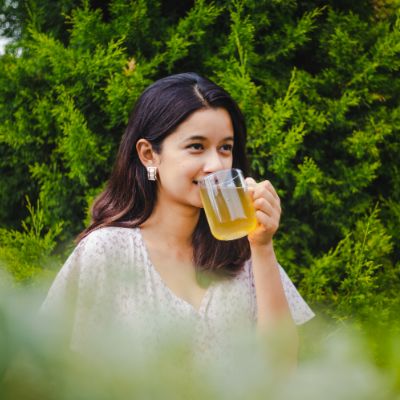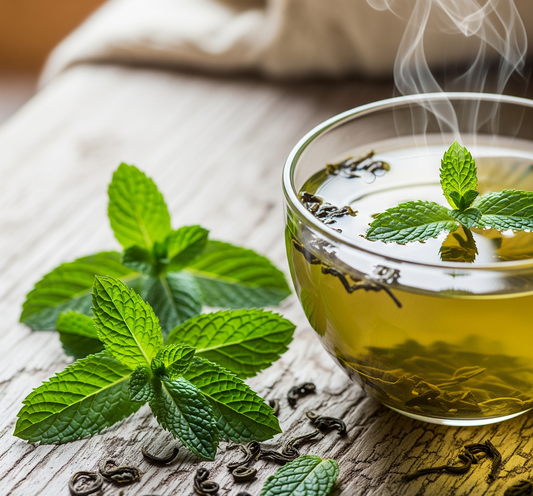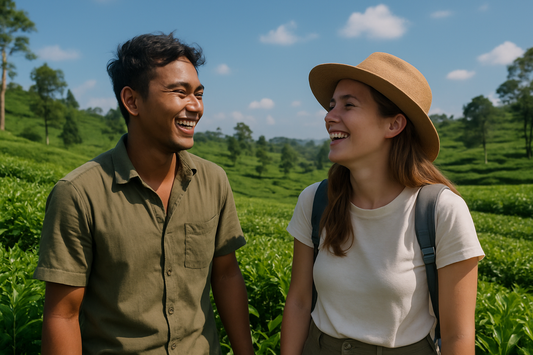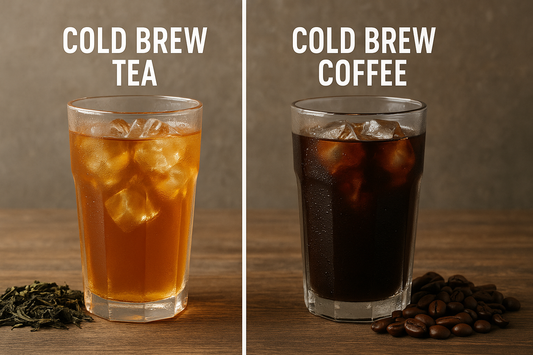Yes, green tea contains caffeine. However, it contains varying amounts of depending on type and preparation. Factors like water temperature, tea-to-water ratio, and steeping time affect caffeine levels. Matcha and Gyokuro are higher in caffeine, while Hojicha and Genmaicha are lower. To control intake, use cooler water, less tea, and shorter steeping times. Opt for low-caffeine varieties. Green tea falls in the middle of the caffeine spectrum, making it a balanced, energizing drink. Enjoy your tea with knowledge of its caffeine content.
Ever found yourself asking, "How much caffeine is in my green tea?" or “Does all green tea have caffeine?” and “How does it stack up against black tea in terms of caffeine?”. Well! Grab a cup of your favorite brew, and let's get started with answering these burning green questions, shall we?
Here's the scoop: there isn't a one-size-fits-all answer. Contrary to popular belief, black tea doesn't always contain more caffeine than green or white tea. The caffeine content in the same black tea varies depending on who brews it and how they brew it. While the caffeine landscape isn't strictly black and white (or green or oolong), several common factors influence how much caffeine ends up in your cup. If you need any further adjustments, feel free to ask!
Does All Green Tea Have Caffeine?

First things first, yes, all green tea contains caffeine. But don’t panic if you’re trying to cut down on caffeine! The amount of caffeine in green tea is generally lower than what you’d find in a cup of coffee or even some other stronger teas like black and oolong tea. On average, According to an article by Mayo Clinic, on average, an 8-ounce cup of green tea contains about 20-45 milligrams of caffeine. This will vary depending on several factors like the type of green tea, how it’s processed, and how long you steep it.
What About Organic Green Tea?
Yes, organic green tea also contains caffeine, but there’s a little more to the story. Organic green tea like Nepal Tea Collective’s Ganesha Green is grown without using synthetic fertilizers, pesticides, or herbicides. This means you’re sipping on a cleaner, more environmentally friendly product. However, the caffeine content in organic green tea is not significantly different from non-organic green tea. So, if you’re opting for organic for health reasons, you’re still getting your caffeine fix.
Types of Green Tea and Their Production Processes
Now, let’s talk about the various types of green tea and the levels of caffeine they possess. There’s a whole world of green tea out there, each with its own unique flavor profile and production method. Here are some of the most popular ones:
Sencha is the most common type of green tea in Japan, produced by steaming, rolling, and drying the leaves. It boasts a fresh, grassy flavor with a slight astringency, and its caffeine level is moderate, typically around 30 milligrams per cup.
Matcha comes from shade-grown tea leaves that producers grind into a fine powder. Since you consume the whole leaf, matcha delivers more nutrients and caffeine. Its distinctive, rich umami flavor and creamy texture provide a high caffeine content of around 70 milligrams per cup, similar to black tea.

Gyokuro, like matcha, also grows in the shade. However, producers do not grind the leaves into a powder; instead, they steam, roll, and dry them. This tea offers a sweet, rich umami flavor and typically contains around 50-70 milligrams of caffeine per cup.
Hojicha stands out because roasters make it by roasting green tea leaves, which gives the tea a unique, toasty, caramel-like flavor. The roasting process reduces its caffeine content, making it a low-caffeine option at about 20 milligrams per cup.
Genmaicha is a blend of green tea and roasted brown rice. The addition of rice not only introduces a nutty flavor but also dilutes the caffeine content. This results in a toasty, mild green tea flavor with low to moderate caffeine levels, around 20-30 milligrams per cup.
How to Control Your Caffeine Intake?
When comparing the caffeine levels in these green teas to other teas, matcha, and gyokuro are on the higher end, similar to black tea with about 70 milligrams per cup. Sencha has moderate caffeine, comparable to many other green teas, while hojicha and genmaicha offer lower caffeine alternatives, suitable for those looking to reduce their caffeine intake without sacrificing flavor. Here are some of our top suggestions if you’re looking to control your caffeine consumption.

Water Temperature
One way to control the caffeine content in your green tea is by adjusting the water temperature. Hotter water extracts more caffeine from the tea leaves. Therefore, if you're aiming to reduce your caffeine intake, consider brewing your green tea at a slightly lower temperature. This can help you enjoy your tea without the extra caffeine.
Tea-To-Water Ratio
The amount of tea leaves you use about the amount of water also affect the caffeine content. Using more tea leaves results in a stronger and more caffeinated brew. To control your caffeine intake, try using fewer tea leaves when brewing your tea. This simple adjustment can make a noticeable difference in the caffeine level of your drink.
Choose Low-Caffeine Varieties
If you’re sensitive to caffeine but still want to enjoy green tea, opt for low-caffeine varieties like Hojicha or Genmaicha. Hojicha has a toasty, caramel-like flavor with about 20 milligrams of caffeine per cup, while Genmaicha offers a nutty and toasty flavor with 20-30 milligrams of caffeine per cup. These varieties allow you to savor green tea without the higher caffeine content found in other types.
Shorten Steeping Time
Another effective way to manage caffeine intake is by shortening the steeping time of your tea. The more caffeine is extracted, the longer your tea is steeped.. By reducing the steeping time, you can lower the amount of caffeine in your cup. This method is particularly useful if you enjoy stronger-flavored teas but want to limit your caffeine consumption.
Lower Water Temperature
Brewing your tea at a lower temperature can also help reduce the caffeine content. Hotter water tends to extract more caffeine, so using cooler water for brewing can result in a tea with less caffeine. This approach is gentle on the tea leaves and can produce a milder, less caffeinated beverage.
All green tea contains some caffeine, but the amount varies widely depending on the type of tea and how you prepare it. By adjusting factors like water temperature, tea-to-water ratio, and steeping time, you can manage the caffeine content in your green tea. Let me know if you need any more changes!
Whether you prefer the high caffeine kick of matcha or the mellow, toasty flavor of Kanchanjangha Verde, there’s a perfect green tea out there for you. And if you're looking to compare it with other teas, green tea generally falls in the middle of the caffeine spectrum, making it a great option for a balanced, energizing drink.
So next time you’re brewing a cup, you’ll know exactly what to expect in terms of caffeine. Cheers to a healthier, more informed tea-drinking experience!




